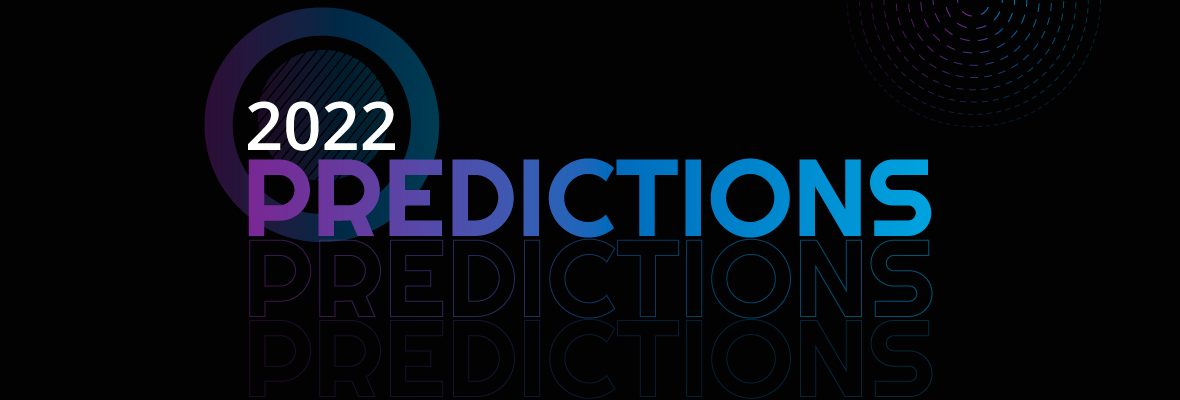2021 brought us widespread COVID vaccines, the Great Resignation, global supply chain disruption, inflation that went from transitory to persistent, accelerated digital transformation in the wake of the pandemic, an attempt at a return to normalcy—and the office—and plenty of uncertainty for the year ahead, thanks to the Delta and Omicron variants.
But when we asked our internal technology leaders at OpsRamp about what to expect for next year in enterprise technology, some clear trends emerged across AIOps, cloud, big data and automation. How software is delivered and supported through the channel figures to evolve as well. Let’s dig in about what to expect in the enterprise IT world in 2022.
AIOps
2021 was surely a big year for AIOps. Our own research indicated that 95% of IT organizations in the US would have AIOps deployed by year’s end. Another 63% said that AIOps would be the focus of their IT tools consolidation strategies. AIOps can help IT to do their jobs better, often with less resources and our experts expect that to be a focus for AIOps usage in 2022.
 |
“AIOps will transition from hype to start focusing on delivering customer confidence in their value claims. This will include increased focus on complex, multi-region and dynamic cloud native applications which require IT vendors to be more open in their data integrations beyond what's built-in, and more agile in adapting and deploying their machine learning models.” Suresh Vobbilisetty, |
 |
“The acute labor shortage evidenced by the Great Resignation across the globe and the offshore hiring challenges will result in companies focusing more on AI-powered automation to make better decisions using data-analytics and drive better productivity, workflow management, and long-term efficiency.” Kaveri Kalavath, |
 |
"AIOps will become a crucial instrument in every DevOps Engineer or SRE's toolkit for a variety of use cases including event correlation, root cause analysis, and auto-remediation. We can expect to see more observability tools to utilize artificial intelligence and machine learning algorithms to improve application and service availability and minimize MTTD/MTTR.” Jay Menon, |
Cloud Computing
While we heard a lot about “cloud repatriation” in 2021, the cloud isn’t going anywhere. Cloud-native, hybrid cloud and multi-cloud will all remain ubiquitous terms and deployment options in 2022. But our experts do expect IT organizations to make better use of their cloud environments and gain better insights on them in the year ahead.
 |
“As businesses start using more and more public cloud & cloud native infrastructure, business operations will leverage service monitoring & log monitoring more than anything else. Remediation based on these metrics will drive efficiencies and improve availability and customer experience.” Viswanatha Raju Penmetsa, |
 |
“With multi-cloud and hybrid deployments, Behavioral Analytics is going to play a major role to understand trends in usage of the business applications and hybrid infrastructure performance. It will be used to suggest recommendations for enhancements, scalability, availability, response, and prescribe accurate standard operating procedures to ensure always-available business services.” Prasad Dronamraju, |
Big Data
You can’t have effective AIOps without good data management and the more cloud resources you’re leveraging, the more data you’re going to have to make sense out of and manage. Data management may not be as sexy as AIOps and cloud, but you can’t utilize these technologies effectively without getting your data right. How you access, store, and maintain your data matters. So, it’s no surprise then that our experts cited trends to watch out for in data management in the coming year.
 |
“There will be an increased focus on data mesh, data hubs and data fabrics for federated data access. Global enterprises and MSPs alike are increasingly demanding a unified and consolidated view of all the intelligence gained from all the data gathered about their customers without violating data residency rules in various regions in the world. Providing this unified visibility requires vendors to be not just cloud native (which is table stakes these days), it requires a fundamental shift to data lakehouse architectures, which combine the best of both worlds from data lakes and data warehouses. Vendors who have not architected both their application and data architectures for global scale will be at a significant disadvantage while those who built their SasS platforms to be truly global from the ground up will be uniquely differentiated. OpsRamp's platform is not just cloud native at the application layer, it is truly global, distributed and highly available at the data layer.” Suresh Vobbilisetty, |
 |
“Given the data residency rules with multiple geographies, it will be more and more critical moving forward for all platform companies to put data residency controls as part of the design itself. The operations teams will require a single-pane view more than any time before, given that deployments can vary across multiple geographies. This will enable remote workers to support /manage the systems with the same rigor.” Viswanatha Raju Penmetsa, |
Automation
Automation has two chief use cases in ITOps: helping you manage changes without taking down your systems (change management) and quickly responding to recurring issues by kicking off the right remediation processes or sending notifications to the right technicians (knowledge management) to respond to problems before they become major incidents. In 2022, ITOps will need to step up its game and do both of these things better.
 |
“Recent high profile outages at some of the worlds largest companies (Facebook, Amazon, etc.) all point to configuration change as the root cause. In 2022, there will be much more focus on leveraging AIOPs, automation and integration with CI/CD pipelines to predict and prevent changes that can cause costly downtime.” Neil Pearson, |
|
“Given that many alerts still do not have any kind of troubleshooting, diagnostics or remediation automation workflows, there will be greater focus on capturing knowledge or improving cross-team collaboration to automate frequently occurring issues to prevent them escalating into incidents.” Neil Pearson, |
The Channel
Technology adoption often depends on how well that technology is sold and supported. The channel remains important to both buyers and sellers of technology and 2022 figures to be the year of the Application Partner (developers of new applications or add-ons on top of existing software platforms, or APs) often allowing enterprises to customize those applications through no-code or low-code deployment.
 |
“Application Partners will be the new players in the market, delivering ‘Packaged Applications as a Service’ offerings to enterprises. This allows MSPs and APs to collaborate and deliver always-available services in their marketplaces, enabling various business units and organizations to adopt no-code or low-code deployments.” Prasad Dronamraju, |
Next Steps:
- Read the blog: IT Operations (and Related) Predictions for 2021
- Read the blog: Avoiding Disaster with AIOps
- Read the blog: The Data-Driven IT Operations Organization






